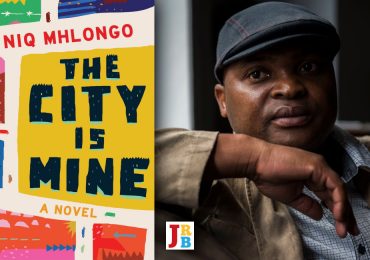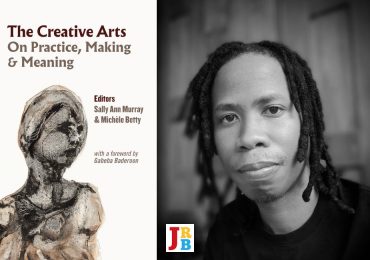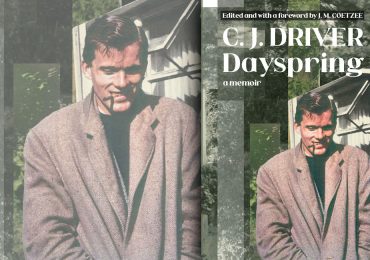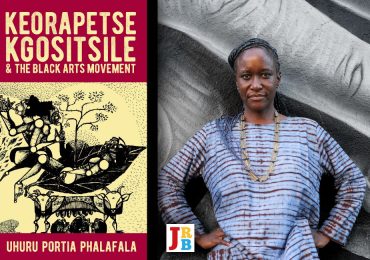The JRB presents an excerpt from Miriam Tlali: Writing Freedom, the latest book by Pumla Dineo Gqola, which brings together original writing, analyses, and, for the first time, the text of Tlali’s previously unpublished play Crimen Injuria.

Miriam Tlali: Writing Freedom
Pumla Dineo Gqola
HSRC Press, 2021
Read the excerpt:
‘In order to understand this country, you have to learn about what was happening. Like everybody else, we are the progeny of our past, our history. And without our history, we are nothing. That is what we should impart into the minds of our children, especially today: that things have been happening, and why things have been happening and why they should be as restless as they can be.’
—Miriam Tlali (Panel discussion, Xarra Books, Newtown, 20 June 2009)
Introduction
On 20 June 2009, I sat in the packed Xarra Books opposite Mary Fitzgerald Square in Newtown, Johannesburg, and listened to Miriam Tlali, who sat flanked by the writers Nokuthula Mazibuko and Zukiswa Wanner. The three authors were part of a panel of women writers that was one of a series of events coordinated by Xarra’s owners, June Josephs and Khanyiso Mguni, to launch the Miriam Tlali Book Club. In the panel discussion, which was scheduled to last for a shorter time but went on from two in the afternoon until a few minutes after five o’clock, Miriam Tlali was in equal turns charming, engaging and critical of power. On this sunny winter afternoon, the event was also the launch of the Canadian Broadview Press edition of her first novel, Between Two Worlds, which had been published earlier as Muriel at Metropolitan by Ravan Press in a much shorter form. Between Two Worlds had been a preferred title of the author’s, published as such in 1979 by Longman, after which it joined the Longman Classics catalogue in the 1980s. Between Two Worlds was translated into German, Japanese, Dutch and Polish. I return later to the tragic tale of Muriel at Metropolitan and Between Two Worlds.
The quotation at the start of this section is from a recording I made of Tlali at the 2009 Xarra event. She was stressing the importance of history as continuity. In various ways, Tlali’s entire career had shown a preoccupation with the relationship of history to the present, and with making connections between moments and movements that did not always appear obviously linked. During this panel discussion, as the afternoon winter sun shone into the beautiful African literature bookshop, Tlali was also careful to highlight the importance of knowledge of one’s history. This knowledge matters beyond functionally knowing which pitfalls to avoid as history ‘repeats itself’, or highlighting self-knowledge. It is as true that we are the products of our pasts as it is that collective action changes the world.
Tlali’s assertion that ‘without history we are nothing’ means that without historical consciousness, we have to constantly start afresh, even if the work, be it political or artistic, has been done—and enabled—in the past. Such amnesia leads to the unenviable task of always imagining the self—or the community—as the first to embark on a certain activist and/or aesthetic journey. This is an unnecessary burden because historical consciousness can be freeing in the ways articulated by Tlali’s literary peer Don Mattera in the title of one of his collections, Memory Is the Weapon. It is not just a trap. Tlali asserted that it is important to spread the word that ‘things have been happening’, to work against erasure, to make connections that legitimise the current restlessness. Indeed, such memory is particularly important in a post-apartheid South Africa whose dominant nationalist discourses of rainbowism and reconciliation are premised on collective amnesia about the brutality of apartheid and a single narrative of a past struggle against which all contemporary activism can only fall short.
For Tlali, this memory or historical awareness is as important in thinking about new forms of activism by young people as it is for making sense of feminist writing and the larger oeuvre of African women’s writing. During the panel discussion at Xarra Books, Nokuthula Mazibuko, literary scholar, filmmaker and author, spoke appreciatively of Tlali’s work in the world, and in her own journey to release creative and intellectual work for public consumption. Panellist Zukiswa Wanner, author and literary activist, half-joked about black women’s writing as a constant flirtation with erasure. For Wanner, a voracious reader schooled in women’s literary traditions across three continents, the use of ‘the first’ in relation to her debut novel, The Madams, grated as much as its labelling as ‘chick lit’. Tlali understood the complicated meanings of being ‘the first’ for a black woman. This is a quandary that feminist curator and artist Nontobeko Ntombela has exquisitely revisited in her own curatorial practice and academic work on the artist Gladys Mgudlandlu. Ntombela notes how biographical framing of artists is often undertaken at the expense of meaningful and sustained engagement with black women’s work. She therefore decides not to approach the archive as just incomplete, but rather to engage a scattered archive, because even when everything is pulled together the scattered-ness remains.
I extend Ntombela’s coinage of a scattered archive to think about Tlali’s oeuvre because I recognise that her contribution—and full literary life —cannot be brought together fully. This is true in a literal sense because there are works by Tlali that scholars cannot access. She told Cheryl Clayton in a 1989 interview that she had written two plays. Even my acquiring the script for Crimen Injuria was the result of a generous chance encounter. Post- apartheid, Tlali told me, Barbara Boswell, Mazibuko and possibly others about a manuscript that had been taken from her by a literary scholar who never returned it. The loss remained a source of unhappiness until the end. And, sadly, it means there are very real ways in which we cannot catalogue everything she wrote.
But the scattered archive is not only a matter of failure. As Ntombela points out, it is productive for us to remember that ‘archives often do not reveal easy answers, but instead probe more questions about the information they contain’. Part of the invitation of the scattered archive is to ask further questions about aspects of Tlali’s work that have already received attention, and not to focus only on the neglected parts of her oeuvre. At the same time, we have to do more than merely revisit those parts of her output that have received no literary criticism. It is important to understand why her microhistories, columns and interviews with a variety of prominent and ordinary people have suffered such neglect.
Because Tlali is ‘the first’ in various respects, some of which are discussed here, literary scholars are likely to feel pressure to spend time placing her work in a lineage of other women’s writing in South Africa, and this certainly is important. Ntombela’s thesis on the scattered archive also engages with the burdensome label of being ‘the first’ for the artist she studies, Mgudlandlu. Being ‘the first’ appears celebratory but the label actually hides the violence that erases a lineage as well as the brutality the pioneer herself is subjected to in the process of being cast as ‘the first’ black woman to publish an English language novel inside the country. It is a ‘burden disguised as honour’, to borrow Zoë Wicomb’s formulation from her novel David’s Story. In Tlali’s case, this allocation of ‘the first’ status requires an avoidance of, among others, Bessie Head (because of where her first novel was published) and Noni Jabavu, Gladys Thomas and others (because of the genre of their first books). Tlali’s status as ‘the first’ also rests on the taken-for-granted elevated status of South African literature in English and Afrikaans over writing in indigenous languages.
In any event, Tlali would not have had access to books by other black South African women writers when she started writing Between Two Worlds in 1964, since almost all writing by black authors was banned after the Sharpeville massacre on 21 March 1960. The massacre was followed by large- scale banning of political parties, activists and writing. More activists were jailed and/or exiled after 1960.
It was, finally, the publication of Muriel at Metropolitan in 1975 which saw her attain this title. For decades, Tlali made no secret of how much she disliked the published version, and how much it pained her to have the version published by Ravan. Below are three extracts from the introduction she wrote to the 2004 Broadview edition of Between Two Worlds that illustrate the extreme pain she associated with the book throughout her life. I have chosen to let Tlali speak in her own words here since paraphrasing her would take up equal space, and because I will return to a discussion of the significant differences between Muriel at Metropolitan and Between Two Worlds.
The first extract is Tlali’s description of her first encounter with Ravan Press:
At Ravan Press in Braamfontein, I spoke to Mike Kirkwood, a much younger man than the Director, Peter Randall. Kirkwood informed me that they liked the novel but … ‘it is too long.’ He added: ‘Publishing is an expensive exercise. We shall have to remove some parts.’ I objected and said: ‘But the book will no longer be the same!’ And the man, stubborn as ever, but smiling, concluded: ‘Go home and think about it.’ Some months later, they handed me the expurgated version. After I had read it, I was devastated and sighed: ‘What have they done to you?’ I looked at the pages as if this was a baby I had given birth to, now reduced to shreds.
I stopped going to the Ravan Press offices, and months later, I wrote to my mother. She took a copy of the manuscript, wrapped it in a spotlessly clean cloth I still have even today.
The second extract details a conversation Tlali had with her mother after a few months of trying unsuccessfully to communicate with a publisher outside South Africa through an intermediary:
‘Masolinyana [my African name], you better allow the South Africans to publish the book.’ I looked at her and shook my head emphatically: ‘No I will not do that, Mé, not the way they want it. It will only destroy it!’ She looked at me and said sadly: ‘I have been waiting too long now. I shall soon die without seeing your book in print, my child.’ And that was the last straw.
The final extract describes the additional hurt caused when she returns to Ravan:
When I arrived back in Johannesburg from Lesotho, I gave Ravan Press permission to publish their version of the book. I signed the contract. As if to add insult to injury, Mike Kirkwood said: ‘Miriam, we shall have to remove the title … Why don’t we just call it “Miriam at Metropolitan”? … That sounds nice, actually.’ I objected: ‘No … I will not have my name used like that!’ The man again smiled and asked: ‘How about “Muriel at Metropolitan” then?’
As the three extracts show, Tlali’s entry into ‘the first’ status was hardly a story of triumph. Her mother died four months after the book was published, a factor Tlali names as her only consolation for a book she never grew to like. In the ‘Her Voice’ section of this book, I have included the equivalent two short chapters from Muriel at Metropolitan and Between Two Worlds. There is a significant difference in word count, and I have further highlighted, in bold, the text missing from the novel published by Ravan. While such visual rendering alone demonstrates significant cutting, reading the juxtaposition of the two reveals much starker differences in characterisation and speaking time allocated to the protagonist. The tracing of these ‘edits’ throughout the book, and the difference they make to Tlali’s characters and overall plot, are the material for an entire study.
Whereas Between Two Worlds received critical acclaim, and even ‘classic’ status at Longman, only Muriel at Metropolitan was available to South African writers. She worked again with Ravan Press in her capacity as one of the founders of Staffrider magazine and its most prolific contributor—writing columns, short stories and microhistories. She published her iconic novel Amandla as her last book with Ravan, choosing Skotaville and David Philip as publishers for her next two books.
Tlali’s movement into public life as a writer was complex and far more layered than the title of ‘pioneer’ would suggest. Rather than dwell on this status of ‘the first’, given the context, I include various evaluations by other literary scholars who comment on this. Jane Bennett issues a crucial reminder about writing when she insists:
Writing is hard: it involves confrontations with critique (from others, and more harsh, from oneself), it involves co-operation with conventions, it requires engagement with public accountability, it demands a self.
Her words suggest the forms through which Tlali’s voice is mediated and staged in this book. Tlali was prolific in her writing; she was very outspoken in her interviews. She worked the boundaries between belonging and individual desires very well.
In the opening quotation to this chapter, Tlali underscored the importance of ongoing engagement with history’s lessons. It was a deceptively simple assertion that requires unpacking, to which I now turn.
First, Tlali affirmed that the disgruntlement with post-apartheid society was legitimate. The radical critique on how much inequality remained and how black people were still trapped in poverty, how limited the structural and economic transformation was, and how the pain of misogyny continued unabated all made sense. And the critique made sense not only as new realisations, although there were new forms of analysis, criticism and political organising. It was also important to realise that previous generations had crafted the tools to make sense of what was (not) happening; it is not always necessary to begin from scratch.
Second, Tlali pointed to the histories of brutality, highlighting that even these had enabling pasts. Recognising the relationships illustrated in the past can help us understand why certain forms of brutality and oppression have such a grip on contemporary events. An awareness of how things happened in the past—not just what happened, but the meanings and specific patterns and expressions—can make a difference in the tools used to make and unmake the world. In other words, sometimes the answer to a puzzle in the present lies in the source buried in a past narrative.
Third, Tlali’s outlook offers a hope-filled departure from many of the prescriptions of older generations about the forms of protest undertaken by members of post-apartheid social and political movements. The quotation ends on her recognition of the current restlessness as not just legitimate but necessary.
~~~
- Pumla Dineo Gqola is Research Professor at the Centre for Women and Gender Studies at Nelson Mandela University. She is the author of five books, including What is Slavery to Me? Postcolonial/Slave Memory in Post-apartheid South Africa (Wits University Press, 2010), the 2016 Alan Paton Award-winning Rape: A South African Nightmare (MF Books, 2015) and Reflecting Rogue: Inside the Mind of a Feminist (MF Books, 2017).
~~~
Publisher information
Miriam Tlali was a novelist, short story writer, playwright, essayist, and activist against apartheid and patriarchal confinement. She worked consistently to build literary and political community, was one of the founders of Staffrider magazine, promoting the work of younger writers, and was the most prolific writer of her time.
Hailed as the first black woman to publish a novel within the country in English under apartheid, and as the first black woman to significantly impact the male terrain of South African short story writing, Tlali held the mantle of many firsts. Fiercely opposed to censorship, she went to great lengths to undermine the will and impact of the apartheid censors and wrote many essays exposing the violence and hypocrisy of apartheid censors. A prolific writer whose plays were performed on two continents, Tlali was routinely banned in South Africa—once after a mere public reading of a story before it was even published. Tlali was recognised as an important South African literary voice, and her first novel was translated into Japanese, Dutch, German and Polish, while it remained banned in the country of her birth.
This new addition to the Voices of Liberation series, Miriam Tlali: Writing Freedom, brings together select original writing by Tlali with analyses of the many ways in which she imagined freedom. Like the other books in the Voices of Liberation series, this title surfaces how Tlali’s writing of freedom retains relevance beyond the specific site and conditions of its emergence.





